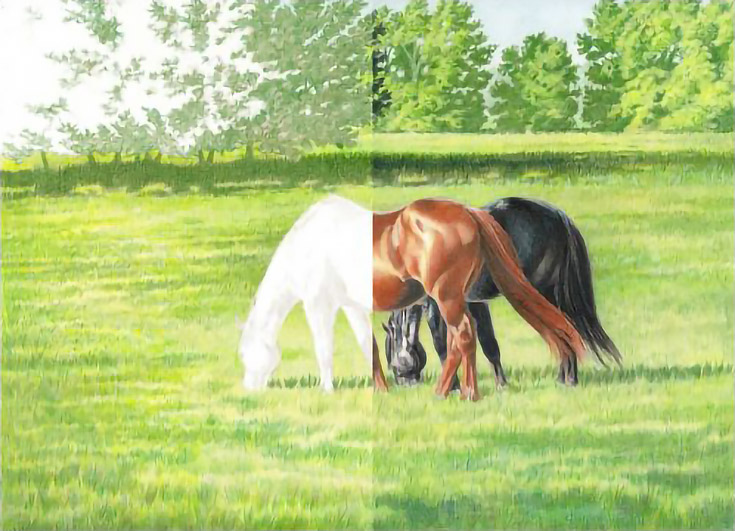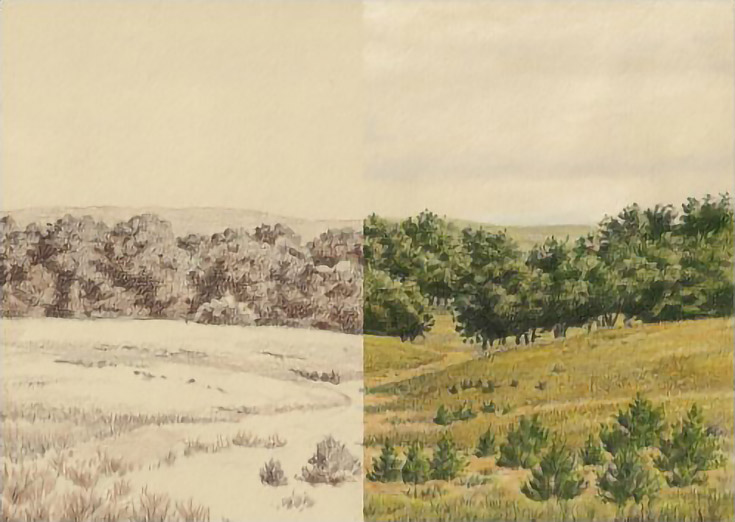Every artist across the ages has spent at least part of their early years looking for the perfect drawing or painting method. Some continue that search all their artistic lives.
I don’t know if it’s the artistic personality, or something else, but there always seems like there could be a better way.
I’m no different. In the 40-plus years I was an oil painter, I experimented with a lot of methods before finally finding one I liked. And when I switched to colored pencils a couple of years ago, I probably should have already had some idea what was going to work, right? :)
As it turned out, I did, but I still had to try several different methods before realizing it!
Here are a few of those methods:
The most intuitive method I tried is what I call the direct drawing method. It’s probably the easiest and most popular way to draw, because it just makes sense. You start drawing with the same colors you end with, and you just draw what you see.
I had difficulty getting realistic landscape greens, though, and that’s when I began looking for other methods. One of those is the complementary method. With this method, you draw an underdrawing in colors complementary to the final colors.
I still use both of those methods at times, but neither one is my favorite.
So what is my favorite drawing method?
The method I return to most often is based on the Flemish Method.
Yeah. I know, the Flemish Method is actually an oil painting technique (I frequently used my own version of it the last few years I oil painted). But since it worked for me with oils, it was logical to try it with colored pencils, too!
Luckily, adapting the Flemish Method for colored pencils wasn’t too hard. Despite the obvious differences (between wet and dry media) the basics were still sound! I pared the entire method down to just an Umber underdrawing with color glazes over the top.
After several years of using an Umber underdrawing for painting horses and landscapes, it’s now my go-to method for all my colored pencil work.
Why I like the Flemish Method of drawing
I prefer the Umber underdrawing method for several reasons. First and foremost, it allows me to develop the values and details of a composition without having to make color decisions at the same time. I don’t know about you, but sometimes throwing color into the decision-making process early in a piece quadruples the complexity. If I can avoid that, I will!
If I’m not sure about a composition—something that happens more than you might expect no matter how much I plan—I can develop it enough to in the underdrawing to see if it’s going to work, and if there are any problems.
Plus, unless I’ve been extremely heavy-handed in layering colors, I can often change those compositional problems before the drawing goes too far. I don’t how you feel about this, but if I can fix a drawing rather than having to start it over, that’s what I want to do! And the sooner the better!
Last but not least, my current top subjects are landscapes and horses (and if I can get those two things in the same drawing, all the better). I’ve discovered that there’s nothing like an Umber underdrawing to keep landscapes looking natural and animals from getting too vivid.
Does that apply to any monochromatic underdrawing?
Yes. You can say all of these things about most colors in your box of colored pencils.
So what makes the Umber method so special to me?
It’s simple: I. Love. Earth tones!
Occasionally I se other colors in the under drawing—usually complementary colors—but those Umbers, Siennas, and other browns are the colors that beckon me most. They find their way into plein air drawings, practice sketches, and ordinary doodles. I’m so comfortable using them that I don’t have to give much thought to color selection in the early stages.
So that’s my favorite drawing method and why I like it.
If you’re at all curious, I encourage you to try it out! And if you need a bit of a tutorial to get started, I can recommend one. It’s one of my first tutorials I wrote for EmptyEasel: How to Create a Colored Pencil Landscape Underpainting.
Even if it doesn’t instantly become your go-to drawing method, knowing when and how to use an Umber underdrawing is a great tool to have in your art toolbox!
This post may contain affiliate links.



